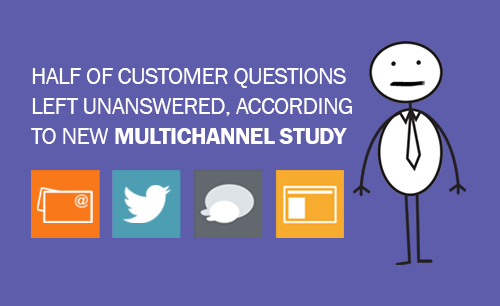Half of customer questions left unanswered, according to new multichannel study

Over the past four years Eptica has been benchmarking the UK customer experience by evaluating 100 leading brands on their ability to provide answers to routine questions via the web, email, Twitter and web chat.
Against a background of ever-more demanding consumers, the 2015 Eptica Multichannel Customer Experience Study has just been released – and it found a growing gap in customer service levels between the best and worst companies. Speed has improved, but too many companies are failing to provide a consistent answer across multiple channels, and far too many questions simply don’t receive a reply at all. You can see the headline results as an infographic here.
The findings demonstrate ten key trends in customer service:
1. The web is the primary digital channel for customer service
In 2012 companies could only answer just over half (53%) of questions asked online. This has improved to 64% in 2015, making company websites the best place to find answers to common questions. Where there was major improvement, the greater use of web self-service systems played a significant role. 90% of banks had deployed web self-service – and they answered an average 91% of questions successfully. 40% of insurers used web self-service – and they could only provide answers to 4 out of 10 questions on average.
2. Email sees improvements in speed and availability
In 2015, there were cautious signs of improvement in email performance. More brands let non-customers email them, and average speed of answer halved from 61 hours 39 minutes to 29 hours 27 min. But while responses were faster, they were less likely to be accurate, with just 39% answering successfully, compared to 41% in 2014.
3. Twitter grows in importance
In 2014 Twitter customer service was fast, yet fragile. Performance improved this year with the chances of receiving an accurate answer growing, from 39% to 41%. Average speed also improved, by over three hours, dropping to 5 hours 27 minutes, from over 8.5 in 2014. However over a quarter (26%) of organisations failed to acknowledge or answer tweets at all.
Customers are becoming increasingly demanding, meaning that company performance cannot remain static. Improvements in speed across email and Twitter are welcome, but need to be judged against continually rising expectations. Six sectors answered tweets more slowly than in 2014, while email speed dropped in six sectors year-on-year.
5. Companies are failing to be multichannel
Sectors (and organisations) varied widely in their performance between channels. Banking ranked top for answering questions via the web, yet joint bottom for email. Telecoms scored an average of 20% on email, but 60% on Twitter. Companies seem to be focusing resources on specific channels. This failure to deliver consistent service to all customers hurts the overall experience and reduces consumer channel choice.
6. Resources are thinly stretched
Companies have to cope with a rapidly growing volume of interactions from consumers across a widening number of channels, often with static or shrinking resources. In many cases it feels that resources are simply stretched too thinly to cope. 44% of emails and tweets went entirely unanswered, and, despite 26% of companies claiming they had web chat, just 9% had it operational when they were actually surveyed. Given the importance of the customer experience, and its direct impact on revenues, resources need to increase if companies are going to thrive.
7. The growth of unichannel
Amazingly, despite the growth in customer contact channels, 15% of companies didn’t provide an answer on either email or Twitter, while just 44% responded successfully on one of these. 6% didn't score above two on their websites, essentially blocking off this channel to consumers. This move to a 'unichannel' world has serious consequences for business. Frustrated consumers will either move to competitors that offer more channels – or will switch to more expensive channels such as the phone, pushing up costs.
8. Widening chasm between best and worst
In 2015, the gap between top and bottom has become even greater. 35 companies performed worse when it came to web customer service since 2014, with 36 improving.
However this is not just a gap between different sectors, but individual companies within them. One utility answered 100% of questions on its website – another just 10%. One insurer responded successfully to a tweet in 9 minutes, while a second answered in 43 hours. In an era of increased choice and customer expectations, consumers are likely to move to those organisations that deliver the best consumer experience, hitting the revenues of those at the bottom.
9. Half of questions remain unanswered
Individual improvements in particular channels and sectors mask an uncomfortable truth. Overall, across 100 of the UK's leading companies less than half (48%) of all questions are successfully answered on email, web and twitter. These figures have remained static over the past two years – essentially there has been no overall improvement in the customer experience for UK consumers from the organisations they typically deal with on a daily basis.
10. Consistency is lacking
When asked the same question on email, Twitter and web chat, just 11% of companies provided consistent answers across two or more channels. Others delivered wildly varying responses. Just two companies offered email, Twitter and web chat – and both of them gave the same answers on all three channels. In contrast others failed to integrate multiple channels, damaging the customer experience and pushing up costs.
The full management report for the 2015 Eptica Multichannel Customer Experience Study can be downloaded here. We'll go into more detail on specific channels and sectors over the coming months, highlighting good practice and lessons that can be learnt by organizations of all types.






